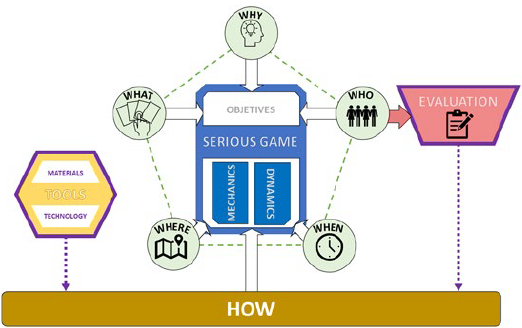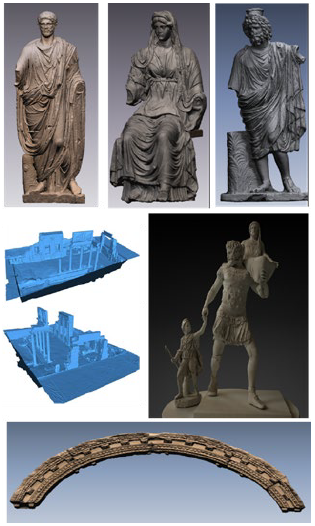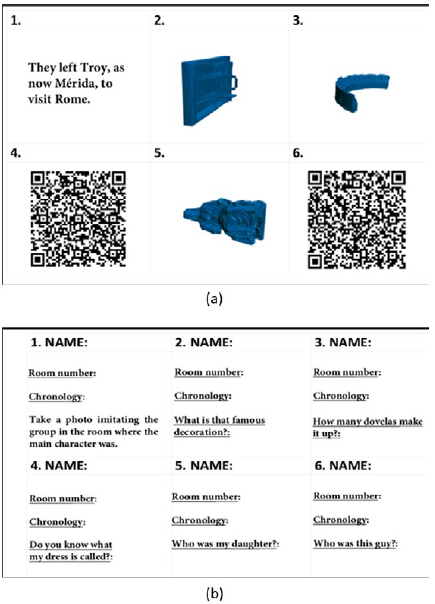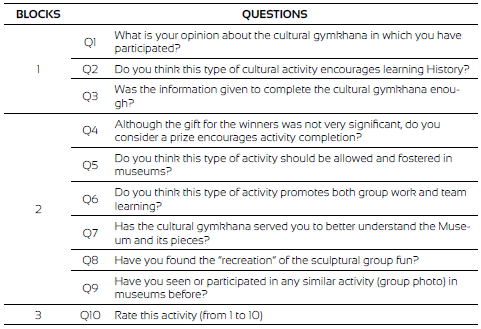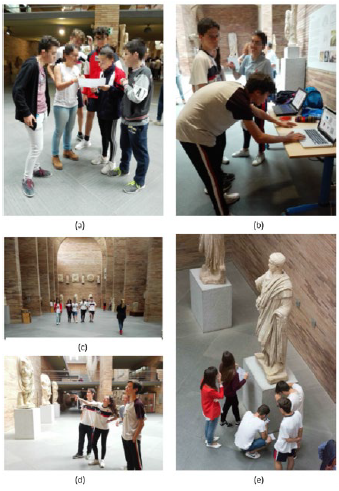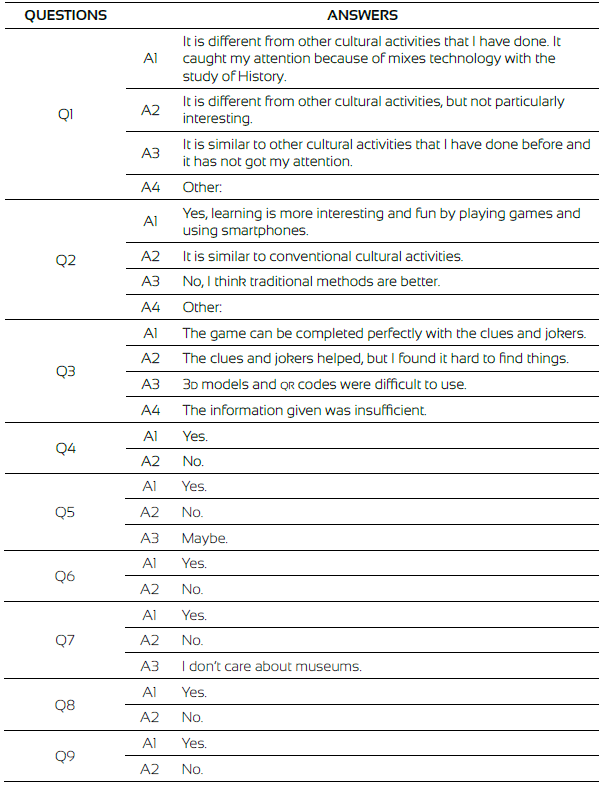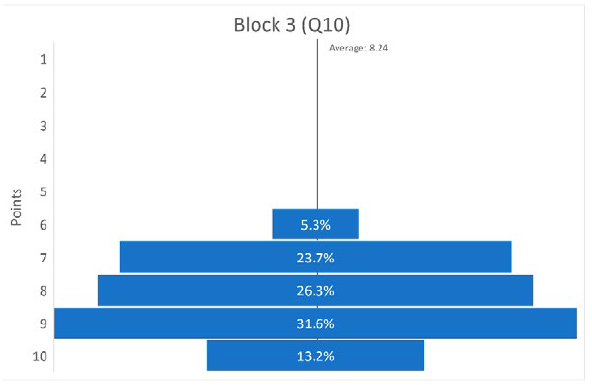Introduction
Playing is an activity eminently related to childhood; through games, toddlers and children improve their social skills and their relationship with their surroundings. However, videogames (played mostly on smart-phones) have become a pretty popular activity that involves new groups of players, mainly teenagers but also youths and adults, in such a way that they spend most of their free time (and even time that is not) gaming (Waweru et al., 2020).
Conversely, teachers do not often perceive the same enthusiasm in the classroom. Kids are usually not engaged inside the class, while most teenagers get bored or do not pay attention during lessons. One of the main reasons for this situation is that they are not usually implicated in their acquisition of knowledge, as they are traditionally considered like mere receivers of information (Mikalef & Chorianopoulos, 2011). So, to involve learners in educational experiences dynamically, some pedagogic methodologies have arisen to attain greater participation of students in their learning process. These methods of educational innovation promote active learning and, with it, the autonomy and participation of the student in the learning process (Murillo et al., 2021). Some of the most popular among teachers today are the Flipped Classroom (Galindo-Domínguez, 2021; Strelan et al., 2020), Project-Based Learning, whose enormous success has given rise to an extensive bibliography covering all educational stages (for instance, in Pre and Primary School: Ferrero et al., 2021; Oktavia & Ridlo, 2020. High School and Higher Education: Fajra et al., 2020; Guo et al., 2020), or Design Thinking (Koh et al., 2015; Panke, 2019).
Among these new instructional dynamics, using games based on technology with educative purposes (also known as "serious games") has become very well-liked within the educational community (Gómez & Suárez, 2021). Serious games are a very effective alternative means in the teaching-learning process (Beavis, 2012), as they provide a rapid engagement of players, attracted by the use of technology and the proposition of a challenge. Therefore, this type of games can involve students in the acquisition of knowledge actively.
Serious games were introduced years ago in formal education as a pedagogical innovation in a learning context traditionally based on receiving information, memorizing content, and answering questions about it in an exam (Essop, 2020; Sánchez & Pierroux, 2015); but today, they are also extensively accepted in informal learning settings (hereafter referred to as ILSS) due to the particular features of this sort of pedagogical environment. Within museums, Art galleries and Science centres, that is to say, the kind of ILSS on which this paper focuses, visitors most of the time act autonomously and knowledge is achieved just by watching. This fact often causes people not to get involved in the exhibition discourse because they get bored soon; for this reason, the permanence time habitually lasts short, which limits the probability of a deep comprehension of the exhibition content. That is why it is necessary to implement strategies that favour the interest and commitment of ILS visitors.
Technology has opened new ways to overcome these problems and to enable the mentioned institutions to explore new possibilities for supplying visitors with more enriching experiences (Rowe et al., 2017). Virtual Reality (VR) and other technological resources can enhance the experiences created (Mariotti, 2021), when kids and teenagers are the main objectives, using information and communications technologies (ids), as this type of users is digital native (Lane et al., 2013). Among new technologies, 3D digitization has become a flourishing technique suitable to be used in learning and research as well as in the field of leisure and entertainment (Pérez et al., 2018). Consequently, 3D models are also a perfect resource for creating teaching alternative activities within any learning setting.
From these premises, we designed the serious game described in this paper to promote the active collaboration of teenagers in their self-acquisition of knowledge and to encourage them to be involved in the activities of ILSS. This game was created to be played preferably inside museums since they are one of the most preeminent learning settings, along with schools (Arbués & Naval, 2014). Nowadays, museums are not only transmitters of culture but also educational agents (Chen et al., 2021). As part of their pedagogical mission, museums develop educational programmes considering the social reality in which they are immersed to strengthen their role as the link between culture and society; for this reason, one of the objectives of museums is to keep abreast of new technological advances to incorporate them not only in their exhibitions but also in their educational and dissemination activities.
Our game mixes technology with the traditional learning method based on printed worksheets. This traditional pedagogic resource has been used extensively in museums and other ILSS to help visitors better understand their museological objectives (Brousseau, 1998). Besides, ours is a game created as a scavenger hunt that forces players to walk around the museum. It aims to replace the usual explanations of the guides with several collaborative tasks whose completion allows a deeper understanding of the exhibits. During this experience, participants play an active role in the interactive search for information about the exhibition pieces.
Firstly, this paper addresses a bibliography review on technology use and serious games in ILSS to set the theoretical framework; secondly, the methodology section introduces the design scheme proposed for developing an experience like the one presented, describes the context in which it was performed: the National Museum of Roman Art (MNAR, by its Spanish acronym), and details the particularities of the presented game; next, the results after carrying out a practical experience are exposed and analysed; finally, the paper ends by drawing conclusions and outlining future work.
Learning Through New Technologies. A review
In museums, Science/Technology centres or even zoos (all of them ILSS), learning is achieved by the contemplation of the exhibits, autonomously or with the help of guides or educators. According to Beavis et al. (2014), Reich y Daccord (2015), and Rowe et al. (2017), visiting these institutions is an excellent way to foster students to acquire knowledge by themselves; however, as mentioned above, visitors often spend short periods touring the exhibition, which limits the in-depth knowledge of its message. Some new teaching methodologies have arisen based on technology to make the visit more attractive and simplify understanding of the ILS discourse.
Mobile devices, for example, are used for this purpose. Thus, some ILS educational activities include mobile devices or mobile phones to place the pieces on display and facilitate the visit (Kriz et al., 2016). Moreover, thanks to smartphones constant improvement and applicability, visitors can explore and even interact with objects through Augmented/Virtual/ Mixed Reality (Falk & Dierking, 2016; Müller, 2017). Building on these advances, animated pedagogical agents that act as guides or educators have also been developed (Bickmore et al., 2013; Lane et al., 2013; Traum et al., 2012; Vosinakis & Avradinis, 2016).
Another resource used to attract and involve visitors in ILS discourse is virtual models. Many institutions offer the opportunity to explore remote (in space and time) objects and places through a simulated reality. These immersive experiences allow visitors to manipulate dangerous or fragile materials and artefacts, to enjoy watching the recreations of ancient remains or to walk distant and sometimes inaccessible archaeological/ natural sites. Learning and comprehending process becomes more straightforward and more engaging to the public through these virtual models (Mortara et al., 2014).
Despite all this, the practical results suggest that mobile technology does not encourage interaction between visitors or between them and their environment, as they focus on the device (Ioannou, 2019; Petrelli & O'Brien, 2018). As a result, the chances of acquiring knowledge decrease. Participants in virtual model experiences must also be prevented from playing a passive role as mere information receivers, which makes learning boring. For all these reasons, to achieve in-depth knowledge and promote interaction, we should find a mechanism that actively involves the participants in their learning process (Mortara et al., 2014).
In this context, serious games acquire relevance; however, to achieve the goal, the game must be entertaining to motivate players to participate. Along with motivation, commitment, challenge, competition, and exploration are also fundamental in educational games (Westera, 2019), as they can help stimulate participants to play and involve them quickly in the game.
As mentioned, serious games have been long used inside formal learning settings as an alternative teaching methodology. But games created for these environments cannot be easily extrapolated to the informal learning contexts, due to the different requirements of both teaching-learning situations. Therefore, serious games for ILS must be designed differently, always keeping in mind the topic to be learned and the applicability of every type of game inside a specific place (Greenspan & Whitson, 2013; Mariotti, 2021; Mikalef & Chorianopoulos, 2011; Mortara et al., 2014; Rowe et al., 2017; Sanchez & Pierroux, 2015).
Literature about serious games in ILS is growing exponentially in recent years; for this reason, a continuous review of the bibliography is necessary to know what has been done and devise future work lines. However, deciding the criterion to follow when reviewing is difficult, mainly due to the quantity and diversity of references. At this point, it is worth noting the large number of serious games held in museums and galleries of History, Archaeology and Art. Two reasons, different and even opposing, can be stated: on the one hand, serious games are an excellent way of attracting students towards these theoretical subjects they often find boring. On the other hand, the historical scenes and the epic battles provide a perfect framework for creating such games.
We decided to classify the papers according to the type of technology used to design the serious game for ILSS. Thus, we will distinguish between those that require mobile devices, those that use Extended Reality, those that recreate virtual environments and those that use other technological options.
For instance, in "Mystery in the Museum" (MÍM) (Simarro et al., 2005), students receive information through that kind of gadget. To solve the mystery, it is necessary to reconstruct the story by gathering all the clues sent to the different groups; meanwhile, "Frequency 1550" (Huizenga et al., 2009) and "Tidy City" (Wetzel et al., 2012), for example, are location-based games that encourage the use of cps technology using mobile devices to enable participants to learn about a specific topic actively.
Using smartphones can also be played the pervasive game "Muse-Us" (Tanguy et al., 2013), the cultural treasure hunts "vEcame" (Bellotti et al., 2003), "My Mobile Mission" (Wyeth et al., 2008), and "O'Munaciedd" (La Guardia et al., 2012).
Concerning Extended Reality, Klopfer et al. (2005) describe one experience developed at the Art Institute of Chicago: participants are provided with handheld devices to answer multiple-choice questions related to various museum pieces, which obliges them to tour the exhibition. This article also explains "Mystery at the Museum", held at the Boston Museum of Science. In this case, each participant assumes a different player role and goes around the museum using a walkie-talkie and a handheld device to collect and analyse virtual clues. A mixed-reality game is proposed by Mikalef & Chorianopoulos (2011): consists of identifying some paintings through QR codes placed next to them. It also deserves mentioning the "SOLOMO" game (Lin et al., 2018), designed for local cultural learning in Taiwan. Equally remarkable is the game "Inventum", which uses Augmented Reality to be played in the Archaeological Park of Venosa (Italy) (Mariotti, 2021).
Another of the most common resources when designing serious games is the creation of virtual worlds (Girvan, 2018), some of them taking advantage of the possibilities offered by 3D modelling. Mortara et al. (2014) show a magnificent review of this type of serious games. Recently, the initiatives performed in Italy with "Night in the Forum" (Ferdani et al., 2020) are a representative example.
Some other types of serious games must be considered, like those that use the versatility of Microsoft Kinect (e.g., Alshammari & Whittinghill, 2015; Yap et al., 2015). It is also remarkable the use of Second Life in libraries and museums (Second Life, n.d.; Stanford University, 2009; Urban, 2007).
But any activity must be created considering the educational context in which it will be developed; in our case, the Spanish Government is working to reduce the school dropout and absenteeism high rates. Thanks to this, some schools and teachers are promoting educational changes that aim to transform and overcome the traditional pedagogical model employing technology (Blanco & Chueca, 2016). Although these efforts are mainly focused on formal education, technology also starts to be used as a helpful complement for education and dissemination in ILSS.
In Madrid, Spain, two leading museums have begun to regularly introduce activities that implement technology to reach a wider audience: the National Archaeological Museum and the Thyssen-Bornemisza Museum (Jiménez-Orellana, 2016; Martín, 2015). Other national museums like the Sorolla Museum (Museo Sorolla, 2021) and the National Museum of Natural Sciences (Museo Nacional de Ciencias Naturales, 2021) have also engaged in this type of experiences recently, In Catalonia, one of the most dynamic regions in using technology in iLs, many institutions are recently applying this type of methodologies. Quite remarkable is the initiative explained by Asensio et al. (2017) and Bossavit et al. (2018). In the same way, some private firms and technical departments of Spanish Universities (e.g., CosmoCaixa or the Universities of Salamanca, Extremadura -thanks to the 3D Covim Lab- and Barcelona) are also getting involved gradually in this type of activities.
Nevertheless, most of these initiatives do not necessarily involve adding the "game" component and only use the technology for the sake of using it. So, proposing serious games in ILSS is almost a novelty in Spain.
Methodology
When designing our game, we considered both the characteristics of the environment and the aim pursued. This game mixes technology (smartphones, 3D digital models, etc.) with other traditional learning methods, and follows the dynamic of a scavenger hunt. We were aware that, although games based on the strategy of scavenger hunt or on solving a mystery encourage interaction among participants and the active seeking of answers, these game types are counterproductive from a learning viewpoint unless they follow a guideline, a discourse that helps to understand the exhibition. If the game does not, the exhibit becomes a set of disconnected and out-of-context pieces, incomprehensible for participants, and far from the original purpose of acquiring knowledge through touring around (Rowe et al., 2017).
Based on these premises, and intending to avoid the weaknesses seen, we propose a "serious game" that mixes the best characteristics of several teaching strategies. It is described under the following headings:
The Cultural Gymkhana: the Design Framework
As mentioned before, this serious game was designed and structured to implement some educational resources validated in the bibliography. We developed a strategy that divides the design of a Serious Game into several blocks which will be specified differently for each particular Game. The schema of this design framework is shown in Figure 1.
In brief, the main task is to define "what", "why", "for whom", and "how" the game will be developed so that it can be adapted to the iLs ("where") and the time, length and specific date ("when"), stipulated by proposers. Of course, the "tools" to be used will influence "how" the serious game will be played which, together with "where" and "when", will help define its "mechanics" and "dynamics". As part of the teaching-learning process, the game should enable students to acquire deep knowledge about a specific topic that must be assessed later ("evaluation"). Once the experience finishes, players fill out a questionnaire that serves as feedback for designers to amend, refocus and improve the proposal to better adapt them to the "objectives".
The idea is to design an activity to complement lessons in the classroom ("what"), due to the need for exploring new technologies and teaching-learning methods ("why"). Players must learn not only about the topic of the setting where they will play but also get familiar with the "tools" (materials, but above all, technology) used. The main "objective" is to engage teenagers ("who") with the ILS message and to acquire knowledge by themselves.
The way the game will be played ("how") is the core of the following explanation. Players are proposed to play a kind of scavenger hunt in which they must answer some questions (evaluation) provided in the traditional paper worksheet (material); here, it is essential to get sure of defining clearly and precisely the criteria and learning objectives according to participants level of knowledge to guarantee the effectiveness of this teaching methodology (Hummel et al., 2017).
Among the technology, the participants will use their smartphones and laptops, one per group, where some clues will be displayed, several of them shown as movable 3D models, as it is our field of expertise. Thanks to a location map, players can move around the place to look for specific pieces and try to solve the challenge proposed in each step; as motivation is essential to achieve knowledge/skills in a participatory way, students are tempted by the possibility of winning a symbolic prize. Thus, participants can see a scoreboard during the game.
The game dynamic is as follows:
» It is designed to be played in groups of up to 5 participants in a space with no significant obstacles that could interfere with the appropriate development of the activity.
» The goal is that players answer correctly, and as soon as possible, some questions concerning the most relevant pieces of the ILS where it takes place.
» For students to answer these questions, we provide some clues shown as 3D models, QR codes or a brief "story", proposed to make them participate more practically; thus, participants must reproduce an Artwork or do a chemical experiment, for example, always depending on the topic of the specific ILS. ICR and 3D models are used to involve players quickly, while the practical task is a great tool to promote collaboration between them.
» Different tables (one per group), each containing 6-8 clues, will be displayed on the laptops; simultaneously, a quiz with questions related to each table will be delivered as a worksheet to act as the evaluation tool; clues order in the tables must guarantee logical learning and avoid overcrowding in certain places during the game. That is why participants must pinpoint the targets following the given sequence. Besides, these targets will be chosen so that their location forces students to explore the space entirely.
Players also have at their disposal three jokers, only to be used once each: they can ask an institution staff member 1) about a location, or 2) about a specific 3D image/model. The game organizers provide the third one, although the information obtained in this case may be true or false.
The use of jokers intends to encourage students to interact with the staff to solve their problems. This way, they also learn this is a helpful resource when visiting facilities of this kind. In sum, through the 3D models, put in a position that obliges the students to move them to identify what it is, the QR codes to be deciphered by the suitable app, and the short "story", players have to locate specific pieces in the exhibition with the help of the jokers. Once pinpointed, they have to look for the answers to the question in the quiz; there are three different ways of solving them:
Directly from the information provided by the institution,
in the encyclopaedias that can be found on the internet or,
from another QR situated near the piece, which links to the technical datasheets of the online collection.
Although mobile phones are not advisable in the Spanish educational system, students should bring their own to play this game on this occasion. Our goal is to show how useful these devices are in the learning process if this technology is used correctly.
Experience at the National Museum of Roman Art
With the game structure fully established, the proposer (the MNAR Research Department staff) defined questions about "where" inside the museum and "when" (even "for how long") it would take place.
Founded in 1838 as an archaeological exhibition of the ancient Roman city of Augusta Emerita (Barrero & Nodar, 2010), the National Museum of Roman Art is the oldest museum in Spain and the most important in Extremadura. Since 1986, a modern building made by R. Moneo houses the entire collection, both architects and museum experts admire this building (Mesa, 2017). It is currently being expanded with new offices, a larger conference room and facilities for didactical activities. Annually, together with the main Roman monuments in Mérida (Theatre, Amphitheatre, Temple of Diana, etc.), the MNAR attracts numerous national and international visitors. It is also a cultural reference inside the autonomous community and the city of Mérida, whose inhabitants feel fascinated by its cultural offerings.
The MNAR has been increasing its pedagogical role since the beginning at its modern location, following the rhythm of the times (Caldera, 2017). Museum's didactic function mainly focuses on learning by discovering, and on competencies development like creativity, problem-solving, interaction with the surroundings and teamwork, which also improves their motivation for learning. In this context, the Department of "Education and Cultural Action", in collaboration with other departments ("Research", "Documentation" or "Conservation"), offers a wide variety of proposals that coincide with important dates, seasons, etc.; for example, summer workshops are proposed for kids with a different topic every year. Through these initiatives, children are immersed in Roman culture with games, costumes, theatre performances, crafts, etc., while enjoying their summer mornings.
Equally, activities such as the "Week of Science" or the "Museum for Youth" are offered to high school and university students and aim to combine leisure, learning and enjoyment of young people within the museum (MNAR, 2021). Despite this, it is difficult to attract and involve children and teenagers, as they tend to visit the museum facilities only out of obligation because they get bored.
Intending to overcome this situation, in the context of International Museum Day'18, we organized an activity for 12-18 year students; it consisted of an immersion experience in the 3D capture and modelling techniques and their usability in modern museums, following the topic of that year, "Hyper-connected Museums: new perspectives, new public". Our proposal of Cultural Gymkhana (cc) was performed as part of that experience so that we could assess its validity with students from High Schools in Mérida.
We selected some relevant pieces following the storyline "Roman private and public monuments": several sculptures (one togatus, one statue of a matron, Pluto, Ceres, the Genius Coloniae, and Chronos), one funerary monument, one ara and one of the Theatre arches. All of them are exhibited on the main floor, the widest of the whole museum, which has neither stairs nor other obstacles. Some pieces had previously been digitized using a short-range scanner (Merchán et al., 2011). We also used the "Aeneas Group", composed of three statues, and the 3D digital model of the Forum Adiectum, a public square of ancient Augusta Emerita (Merchán et al., 2012) (see Figure 2).
This way, Pluto, Ceres, the togatus, the arch, and the forum, could be shown as movable 3D models. Using this type of resource has a double purpose: on the one hand, it allows participants to become familiar with models of this kind; on the other hand, most of the pieces are exhibited with their backs against the wall. Ergo, these models are the only possibility for students to see their rear and other non-accessible parts. Concerning the non-digitized pieces, a picture of each was transformed into a QR code and added to the table (see Figure 3a).
Regarding the short story, it had to guide players to the Aeneas sculptural group, which was not in the Museum but on display in Rome at that moment; so, once found the room where it is usually exhibited, students could see only a picture, instead of the original pieces; the picture showed the virtual reconstruction of the group they had to recreate and photograph. Thus, every team member had to represent one of the characters: the kid, Ascanius; the father, Aeneas; or the grandfather, Anchises. As the groups were of five students, another participant took the photos, and the last one led the operations. It is a collaborative experience in which every player takes a role to reach the best solution in coordination with the others.
Description of the Experience
Participants: 25 males and 13 females (aged 14-16) participated in the experience. They were divided into two shifts of 19 to avoid bothering museum visitors; in turn, we grouped each shift into four teams of five members. One person from the museum staff played like a regular student in the group with one less participant.
Material and methods: The tables with the clues were displayed on computers so that players could interact with the movable 3D models, as said (see Figure 3a). The quiz was provided in a worksheet (see Figure 3b) with a location map on the back and a pen to fill it in. This way, each group had to distribute tasks and elect a person responsible for each.
Explanation: At the beginning of the activity, we explained the rules orally: what the game consisted of, how they should play it, and who could provide the information if they decided to use the jokers; the main rule was to behave appropriately and not interfere with the normal functioning of the museum.
Time length: Initially, participants had 30 minutes maximum to complete the game; however, the experience had to be extended by some more minutes for all teams to finish.
The main objective of this activity was the students could learn from the museum's collections. For this reason, priority was given to everyone finishing it, although the winner was among those who had answered all the questions correctly in the shortest time.
Evaluation: In this case, teachers would evaluate students in the classroom, following the usual rules of formal learning environments. Therefore, the questions in the worksheet did not mean to fulfil that mission, but to serve as a guide in the study and as a method for acquiring and retaining knowledge to be assessed later.
Award: Every member of the winning group received a symbolic prize provided by the museum.
As experience shows, teenagers do not usually stay interested in doing the same task for long, even more, if it does not provide them with a direct benefit. That is why we conducted only a 10-question satisfaction poll with multiple-choice answers; arranged in such a way they allowed us to assess some of the most interesting points for the correct interpretation of the experience (see Table 1). All students completed the poll anonymously.
We can divide the questions into three blocks:
» Q1-3 were set out to verify if the proposal was well accepted and its degree of acceptance; therefore, extensive answers are needed to find the details.
» Q4-9 refer to the specific mechanism of the game and its validity for bringing young people to museums. These were YES/NO questions.
» Q10 evaluates the whole activity, so a 10-point rating was requested.
Results
The immediate results -observed during the experience- showed that the students were very dynamic from the beginning, engaging in the activity proactively and hoping to be the winners. They interacted without problems with the museum staff too, when they could use the game jokers (see Figure 4). Likewise, the solutions they found to reproduce the Aeneas Group were very imaginative (see Figure 5). But, above all, they were very polite at any moment not to bother the other visitors.
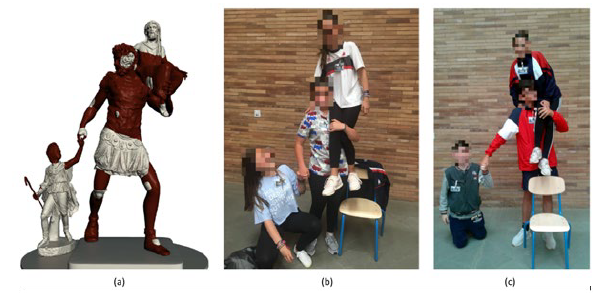
Figure 5 (a) Reconstruction of the sculptural group with Aeneas, Anchises and Ascanius; (b, c) Live recreation
Regarding the satisfaction poll that participants answered at the end of the experience, Table 2 presents the possible choices they had to make, and Figures 6-8 show the statistics of the selected options.
QUESTIONS ANSWERS
In short, the general opinion was quite favourable, as can be seen analysing Block 1 (see Figure 6). Concerning Q1, 94.7 % [76.3 (A1) + 18.4 (A2)] indicated that this cc is different from other cultural activities in which they had participated. Among them, 76.3 % highlighted their interest by remarking that the experience attracted their attention as it used new technologies in History study; however, 21 % [18.4 (A2) + 2.6 (A3)] showed their indifference to Cultural Gymkhana while one participant (2,6 %) used the option "Other" to complain because the game makes less use of new technologies than he/she would have liked.
As said, the purpose of Cultural Gymkhana was for students to learn Roman history in the museum through an entertaining activity. To engage them in the resolution of the tasks, they had to move around MNAR collaborating actively with other students and using occasionally new technologies. The graph corresponding to Q2 shows that 78.9 % [76.3 (A1) + 2.6 (A4)] of the participants stressed that these characteristics of the serious game had motivated them to be involved in its resolution; the percentage that chose option 1 admitted that cc is a good way of learning compared to "traditional" methods, as it is more interesting and fun, the other 2.6 % complained about bad connectivity in this informal setting, which had avoided a quicker resolution; however, more noticeable is that 21 % [10.5 (A2) + 10.5 (A3)] indicated that using this methodology did not encourage their interest in learning since they consider that cc is as good as other teaching-learning activities (10.5 %) or even worse than "traditional" methods (10.5 %).
To finish this block, Q3 talks about difficulties in playing the game. In this case, 94.7 % [60.5 (A1) + 34.2 (A2)] of participants emphasized the usefulness of clues along with game jokers offered, which helped in its resolution and reduced its difficulty; nonetheless, although the majority (60.5 %) considered that Cultural Gymkhana could be solved easily with the help of these elements, a significant 39.5 % [34.2 (A2) + 2.6 (A3) + 2.6 (A4)] found some complications. Thus, while 34.2 % complained about the complexity of finding things, despite the clues and jokers, the remaining students (5.2 %) showed their rejection of this serious game, either because it was not easy for them to handle 3D models or QR codes or because they considered the information provided to its resolution was insufficient.
The high percentage of acceptance obtained in Q5, Q6 and Q7 (84.2 % each) also support the positive opinion about cc; those questions checked the truthfulness of the previous answers (see Figure 7). That is to say, a high percentage of the participants pointed out that the serious game helped them to know MNAR and its pieces better, that this activity promotes work and learning in groups, and that this type of recreational activity based on new technologies should be allowed and encouraged in museums, objectives pursued in this serious game design. Participants also very well accepted the live recreation of the sculptural group. Although 31.6 % admitted that this type of activity was not novel for them (Q9), 89.5 % of the participants highlighted that it had been fun (Q8). Finally, the use of an honorary prize to encourage the completion of the Cultural Gymkhana was well-liked by 81.6 %, who answered "Yes" to Q4, whereas just 7 people chose the option "No".
Note that in both Figure 6 and Figure 7, a line has been introduced to separate the positive responses from the negative/neutral ones, dividing the graph into two distinct zones: a green zone showing the good acceptance of our proposal, and a red one reflecting the disapproval of it. In both cases, the green zone is much larger than the red zone, showing the supportive feedback from the players of this serious game.
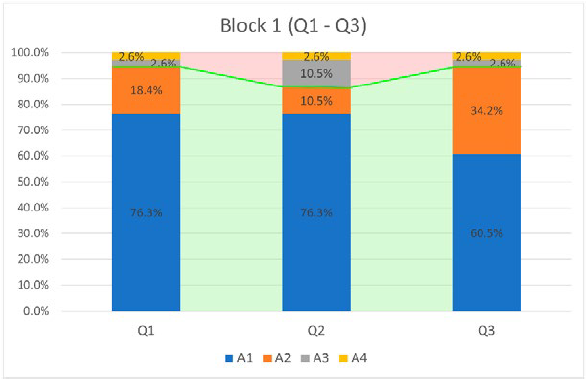
Figure 6 Statistics of questionnaire results, Block 1: Questions 1 to 3 - Acceptance of the proposal
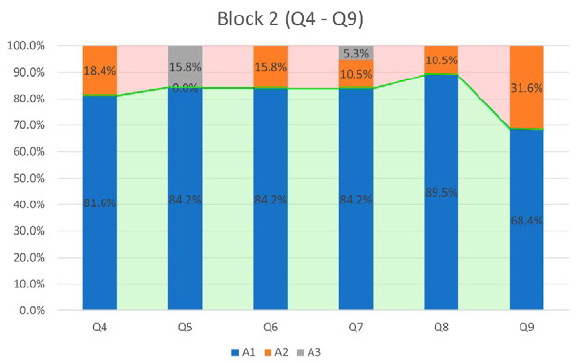
Figure 7 Statistics of questionnaire results, Block 2: Questions 4 to 9 - Validity of the game mechanism
Concerning Q10 (Block 3 - Figure 8), players scored cc with 8.24 out of 10: it was scored twice with '6' and graded with 'outstanding' (9-10) seventeen times; besides, the most selected scores were '8' and '9', but, 11 of the 38 participants (29 %) expressed moderate satisfaction, probably due to the difficulty in its completion.
In sum, analysing the satisfaction poll as a whole, we can say that the objectives pursued by creators: applicability (Q5), group work (Q6) and acquisition of knowledge (Q7), obtained a positive score of 84.2 %. The mechanisms used to foster learning -clues and jokers (Q2), prize (Q4), and group photo (Q8)- got a very high percentage of acceptance (76.3 %, 81.6 % and 89.5 %, respectively). Q9, which complemented Q8, tried to evaluate the novelty of proposing a live recreation and whether it is a mechanism to encourage group work. Although 31.6 % admitted that this type of activity was not new to them, the high percentage of satisfaction obtained -also reflected in the marks given to the activity (Q10) - leads us to think that it is a worthy resource to use in subsequent experiences.
Conclusions
The literature review has shown that we can use digital technologies, virtual models, and serious games to involve visitors in knowledge acquisition while visiting ILSS; however, these resources have specific shortcomings that must be overcome in the designing of an experience: often, the application of digital technology or virtual models has not had the desired effect, either because visitors isolate themselves when using these technologies, or because they adopt a passive role during immersive experiences. It seems that using games could help to improve the experience inside museums. Serious games have been very accepted, because learners are motivated during the fun and entertaining game experience and, as a consequence, they take part in the act of gaining knowledge or skill in an active role; nonetheless, to guarantee success, there should be a strong compromise between deep knowledge and exploration of the informal educational environment during the experience.
In this sense, our Cultural Gymkhana was created to allow learning by replacing the traditional explanations in guides with collaborative tasks that only can be solved by moving around the place using game mechanics. In-depth knowledge is guaranteed, on the one hand, by forcing participants to interact with 3D models and photographs. It obliges them to explore details that cannot be directly observed; on the other hand, by making them read technical information related to the pieces to answer the quiz.
The practical experience carried out has shown great promise for learning through interactive activities in a museum, as can be deduced from the results of the satisfaction poll, while we are aware that, to get more reliable results, it would be necessary to test it on more occasions and by widening the age range of the participants, future work lines can be drawn from it. As for improvements, technological resources (3D models, QR codes, etc.) should be easier to handle, the use of ICT greater, and the Internet connection must be guaranteed; also, participants well accepted the paper quiz, but an online quiz would ensure instant feedback (besides being auto-evaluable). From an evaluation view, developing a rubric could be useful to assess in depth the knowledge acquired.
But, in sum, although some aspects should be improved, the proposed cc seems to be a very appropriate and versatile tool to promote knowledge acquisition and social engagement in us.














